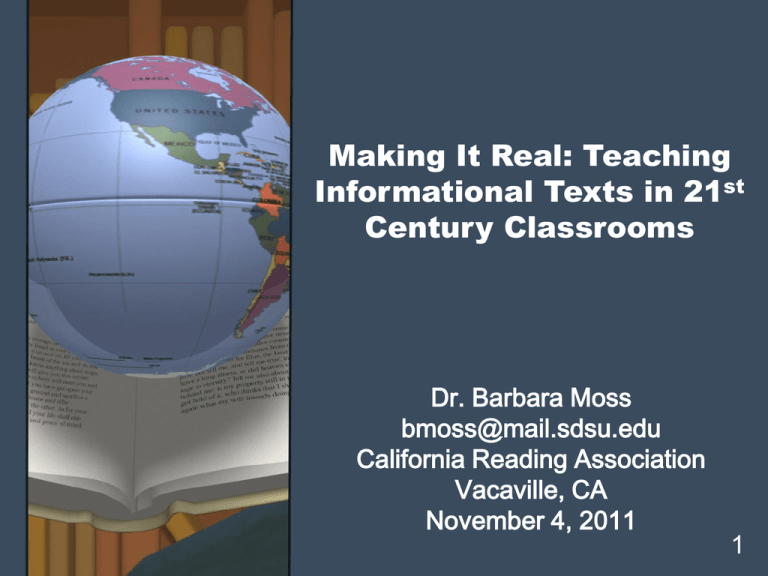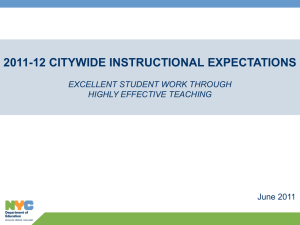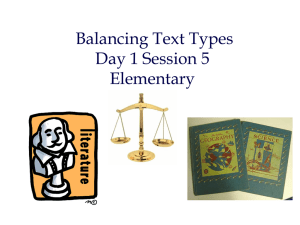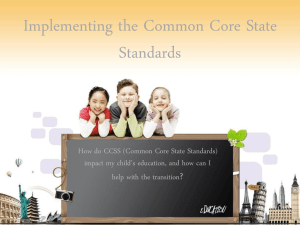Teaching Informational Texts in 21st Century Classrooms
advertisement

Making It Real: Teaching Informational Texts in 21st Century Classrooms Dr. Barbara Moss bmoss@mail.sdsu.edu California Reading Association Vacaville, CA November 4, 2011 1 To Think About… With your partner, make a list of everything you have read during the past 24 hour period. 2 What is Informational Text? 3 What is Informational Text? Newspapers Magazines Encyclopedias Digital information Information trade books Almanacs Textbooks 4 Why Use Informational Texts? By sixth grade, 80% of school reading tasks are expository (Venezky, 2007) 80% of adult/workplace reading is informational Need to close the “knowledge gap” (Hirsch, 2006) Can motivate reading Standardized tests are 85% expository (Daniels, 2007) 5 “Students’ success or failure in school (and out of school!) is closely tied to their ability to comprehend expository text” (Kamil, 2003). 6 Why does it matter more than ever? 7 Six Shifts in the Common Core (CCSS) ELA Standards 50% informational text in K-5 to build background knowledge across levels Grades 6-12- broad base of content literacy Increased text complexity Focus on textdependent questions Greater focus on academic vocabulary(Tier 2 words); less on literary terms Writing focused on argument, not personal narratives 8 CCSS: Informational Text We in America in K-5 focus 80% of our time on stories…that is what is tested on exams and in our textbooks..yet in K5, the general knowledge you develop plays a crucial role in your performance in other disciplines and your ability to read more complex texts. So the CCSS demand that 50% of the texts students read in K-5 is informational, primarily about science and history, the arts…the texts through which students learn about the world. David Coleman, CCSS 9 Teaching Content is Teaching Reading… http://www.youtube.com/watch?v=RiP-ijdxqEc 10 CCSS Anchor Standards K-5 Key ideas and details details and inference relationships between events Craft and structure vocabulary text features macrostructure/comparing Integration of knowledge and ideas visuals reason and evidence integrate information multiple sources Text complexity 11 Three Informational Text Gaps…. The Achievement Gap The Exposure Gap The Instruction Gap 12 The Achievement Gap: Test Scores 4th Grade slump (Chall, Jacobs, and Baldwin, 1990) Scores on 2009 NAEP informational text for English learners far lower than for native speakers (190 vs. 219) (National Center for Education Statistics, 2009). 13 The Exposure Gap First graders spent 3.6 minutes a day with informational texts (Duke, 2000) Students need exposure to a range of informational texts, not just biography (Dreher & Voelker, 2004) Many California students get little or no social studies or science instruction (Wineburg, 2006) 14 Thinking about genres… 15 16 17 18 19 CCSS Informational Text Categories Literary Nonfiction Exposition Argument/Persuasion Procedural 20 Literary Nonfiction Combines factual elements with information Uses literary devices as well as informational text structures Focus on text structures 21 Exposition Straightforward information Academic vocabulary is crucial to meaning Textbook like 22 Argument/Persuasion Texts that use arguments and evidence to convince the reader of their position 23 Procedural Texts/Documents Step by step texts that describe how to complete a task Technical documents 24 Distribution of Text Types on NAEP/Common Core Standards Grade Literary Information 4 50% 50% 8 45% 55% 12 30% 70% 25 Basal Informational Selections by Type (Moss, 2008) Genre Series Pri Int Lit NF HM 31% 23% SRA 29% 61% HM 52% 63% SRA 63% 37% HM 0% 4% SRA 0% 3% HM 17% 11% SRA 8% 0% Expos Arg/Pers. Proc/Doc 26 CCSS Emphasis on Complex Texts Non-required exemplar texts are challenging (see Appendix B) Recommend a staircase of increasing text complexity year by year Texts need to be more complex for students to be college and career ready 27 The Instruction Gap Research continues to confirm lack of comprehension instruction of any type in K-6; especially informational text (Durkin, 1979; Taylor, Pearson, Clark & Walpole, 2000) 28 CCSS: Text-Based Instruction Need close reading, not just skimming and scanning for facts Too much time building background, not enough close reading Emphasis on argument/evidence Read, reread more difficult shorter texts 29 How Should Instruction Change? Make time for informational texts More attention to text macrostructures Content integrated thematic units Get beyond just teaching text features and one genre of informational text (biographies!!!) Tiered texts of increased complexity Deeper teaching of comprehension 30 Gradual Release of Responsibility 31 CCSS: Sample Tasks Describe the overall structure of events ideas, concepts or information in a text. Recount key details in a text. Compare and contrast a firsthand account of a topic with a secondhand account, attending to the focus of each account and the information provided by each. Students evaluate an argument and challenge it using evidence. 32 Table of Contents Prediction Present a book cover Students predict table of contents by chapter Gets students thinking about text macrostructure, sequence of presentation of information Promotes reflection on big ideas of text 33 34 Table of Contents • • • • • • • • • A Deadly Storm The Hurricane Begins to Develop Preparing for the Hurricane Waiting for the Storm Mitch Hits? Swept Away! Recovery Glossary Index 35 Expository RetellingsRecounting Details • • • • Retellings are familiar to teacher through DRA Should be used with exposition, not just narrative Help kids internalize text structures Requires them to “read, reread, and read again” or listen intently • Develop oral language abilities • Show teachers how students organize information 36 36 37 Teach Text Structures: Webs or Charts Help children segment text Keep track of information See how text is organized (description, cause effect, comparison contrast, problem solution) 38 gray brown black wasps toads frogs Enemies Appearance trapdoor widow tarantula Head- chest Their bodies Types of spiders water sheet Spiders abdomen unlike insects How they reproduce orb Types of webs tangled Spiderlings Lay eggs in a silk sac Care for selves Ballooning triangle funnel 39 Strategy Framed Writing: Winterizing a Car First get everything you need. You will need oil, antifreeze, oil filter, and hoses. Second, lift up the hood and screw off the oil filter. Put in new oil and the new oil filter. Thirdly check the antifreeze adding antifreeze to the radiator if it needs filled. Next, put water in the battery. Close the hood. Finally, check the gas to make sure you have enough before taking off. 40 The Great Depression in California The '30s produced both shantytowns full of displaced Okies and the soaring beauty of the Golden Gate Bridge. Charles Dickens had it right: It was the best of times, it was the worst of times. The '30s really began in 1929 with a crash and ended in 1941 with a war. Oct. 29, 1929, was the day the stock market crashed -- but it was more than just a Wall Street problem. The bottom dropped out of the economy almost at once. The unemployment rate, only 3 percent in 1925, was 25 percent in 1933. Some 9,000 banks failed across the United States, farm prices dropped by half, and the stock market lost 80 percent of its value between 1930 and 1933. Thousands of people lost their homes to the banks. Millions of people were out of work, and some were near starvation. Franklin Roosevelt created a variety of programs, including the California Conservation Corps, and the Works Progress Administration to give people jobs. 41 Victorville, CA January 17, 1933 Dear Grace Bless your heart how did you know how bad we needed the ten dollars. So bad we didn’t have a cent. We have lost everything we have. Our little home will be sold the first of April and we have moved up in the mountains 116 miles from Lynwood. I could not bear to stay there and see our life savings taken from us. We would have been all right if the boys could have work. We are living on a ranch. We don’t have to pay any rent and have plenty of water from the mountain just back of the shack we live in. We have no gas or water bills to pay but we have electric so we have the radio to listen to. We have enough to eat so far. The Red Cross gives us flour and we have chickens. Hope you can come visit us. Aunt Jane. 42 http://www.youtube.com/watch?v= nrxmpihCjqw 43 Now…evaluate yourself!! Where are you as a teacher of informational texts??? 44 45 46







